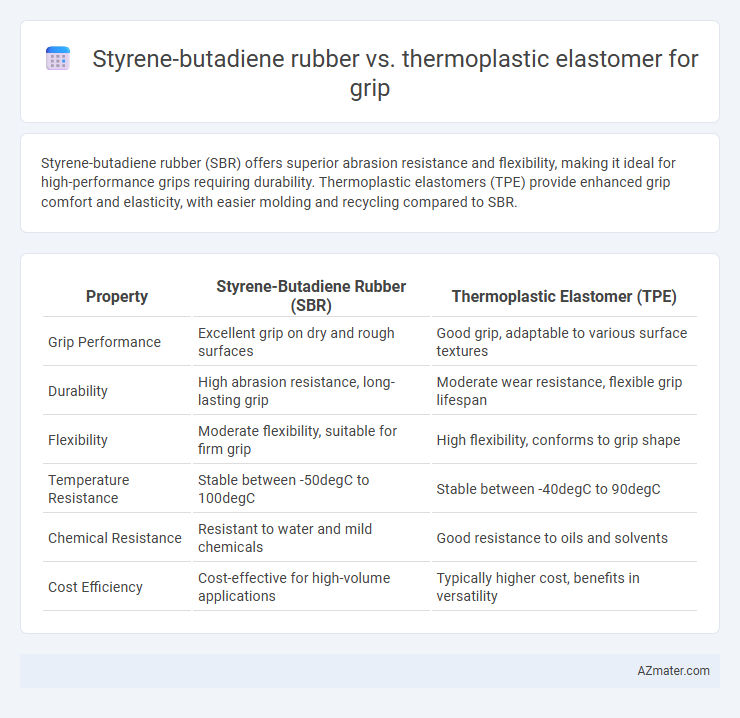Styrene-butadiene rubber (SBR) offers superior abrasion resistance and flexibility, making it ideal for high-performance grips requiring durability. Thermoplastic elastomers (TPE) provide enhanced grip comfort and elasticity, with easier molding and recycling compared to SBR.
Table of Comparison
| Property | Styrene-Butadiene Rubber (SBR) | Thermoplastic Elastomer (TPE) |
|---|---|---|
| Grip Performance | Excellent grip on dry and rough surfaces | Good grip, adaptable to various surface textures |
| Durability | High abrasion resistance, long-lasting grip | Moderate wear resistance, flexible grip lifespan |
| Flexibility | Moderate flexibility, suitable for firm grip | High flexibility, conforms to grip shape |
| Temperature Resistance | Stable between -50degC to 100degC | Stable between -40degC to 90degC |
| Chemical Resistance | Resistant to water and mild chemicals | Good resistance to oils and solvents |
| Cost Efficiency | Cost-effective for high-volume applications | Typically higher cost, benefits in versatility |
Introduction to Grip Materials: SBR vs TPE
Styrene-butadiene rubber (SBR) offers superior abrasion resistance and excellent grip due to its high tensile strength and elasticity, making it ideal for applications requiring durable and reliable traction. Thermoplastic elastomers (TPE) provide versatile grip properties with enhanced flexibility, ease of processing, and recyclability, suitable for ergonomic designs and lighter-duty grips. Both materials balance grip performance and cost-effectiveness, with SBR excelling in heavy-use scenarios and TPE favored for customizable comfort and sustainability.
Composition and Structure Differences
Styrene-butadiene rubber (SBR) consists of a synthetic copolymer formed by styrene and butadiene units, creating a cross-linked, vulcanized network that provides excellent abrasion resistance and moderate elasticity, ideal for enhanced gripping surfaces. Thermoplastic elastomers (TPEs) combine hard thermoplastic segments with soft elastomeric blocks within a linear or block copolymer structure, enabling reversible physical cross-links that offer flexibility and superior grip under various temperature conditions without the need for vulcanization. The vulcanized, chemically cross-linked network of SBR delivers durable, consistent grip performance, while the phase-separated morphology of TPEs allows adaptable mechanical properties and improved tackiness, particularly in applications requiring repeated deformation and recovery.
Key Performance Characteristics for Grip
Styrene-butadiene rubber (SBR) offers superior friction coefficient and abrasion resistance, making it ideal for high-traction grip applications where durability under repeated contact is critical. Thermoplastic elastomers (TPEs) provide enhanced flexibility and elasticity with consistent grip performance across a wider temperature range, supporting ergonomic and comfort-focused uses. Both materials balance grip strength and wear resistance, but SBR excels in high-impact scenarios while TPEs offer customizable surface textures for optimized tactile feedback.
Comfort and User Experience Comparison
Styrene-butadiene rubber (SBR) offers excellent grip due to its high abrasion resistance and excellent traction on various surfaces, enhancing overall comfort during prolonged use. Thermoplastic elastomers (TPE) provide superior flexibility and cushioning, resulting in a softer feel and improved user experience by adapting to hand contours and reducing fatigue. While SBR excels in durability and slip resistance, TPE delivers enhanced tactile comfort, making it ideal for applications prioritizing user ergonomics.
Durability and Wear Resistance Analysis
Styrene-butadiene rubber (SBR) offers superior abrasion resistance and long-term durability, making it ideal for high-wear grip applications. Thermoplastic elastomers (TPE) combine flexibility with moderate wear resistance but typically exhibit lower durability under constant friction compared to SBR. The improved molecular stability and cross-linked structure of SBR result in enhanced lifespan and consistent performance in environments demanding strong grip durability.
Flexibility and Elasticity Evaluation
Styrene-butadiene rubber (SBR) exhibits superior elasticity and flexibility compared to most thermoplastic elastomers (TPEs), making it highly effective for grip applications requiring dynamic deformation and recovery. SBR's molecular structure allows for excellent tensile strength and abrasion resistance, enhancing grip durability under repetitive stress. Thermoplastic elastomers offer moderate flexibility but often fall short in elastic resilience, resulting in reduced performance in high-stress or high-flex cycles.
Environmental Impact and Sustainability
Styrene-butadiene rubber (SBR) and thermoplastic elastomers (TPE) differ significantly in environmental impact and sustainability, with TPEs offering better recyclability due to their thermoplastic nature, enabling easier reprocessing and reduced landfill waste. SBR, a synthetic rubber derived primarily from petrochemicals, poses challenges in biodegradability and recycling, contributing to higher carbon emissions and long-term environmental persistence. The life cycle assessment of TPEs generally shows lower ecological footprints and enhanced potential for circular economy integration in grip applications compared to traditional SBR materials.
Manufacturing and Processing Considerations
Styrene-butadiene rubber (SBR) offers superior abrasion resistance and flexibility, making it ideal for high-performance grip surfaces in manufacturing processes requiring vulcanization and curing stages. Thermoplastic elastomers (TPE) enable faster production cycles due to their melt-processable nature, allowing injection molding and extrusion without vulcanization, which reduces cycle times and tooling costs. Processing TPEs provides enhanced design flexibility and recyclability, although they may have lower heat resistance and mechanical strength compared to SBR in grip applications.
Cost-Effectiveness and Market Availability
Styrene-butadiene rubber (SBR) offers superior grip performance in industrial applications due to its high abrasion resistance and excellent traction on wet surfaces, making it cost-effective for heavy-duty usage. Thermoplastic elastomers (TPEs), while providing moderate grip, excel in flexibility and easier processing, resulting in reduced manufacturing costs and broader market availability in consumer goods sectors. The choice between SBR and TPE depends on balancing grip quality against budget constraints and supply chain efficiency in diverse industrial markets.
Conclusion: Best Material for Superior Grip
Styrene-butadiene rubber (SBR) offers exceptional grip due to its high abrasion resistance and excellent traction on wet and dry surfaces, making it ideal for performance-focused applications. Thermoplastic elastomers (TPE) provide superior flexibility and customization with moderate grip levels but may lack the consistency and durability of SBR under heavy use. For superior grip performance, Styrene-butadiene rubber remains the best material choice, especially in demanding conditions requiring reliable traction and wear resistance.

Infographic: Styrene-butadiene rubber vs Thermoplastic elastomer for Grip
 azmater.com
azmater.com